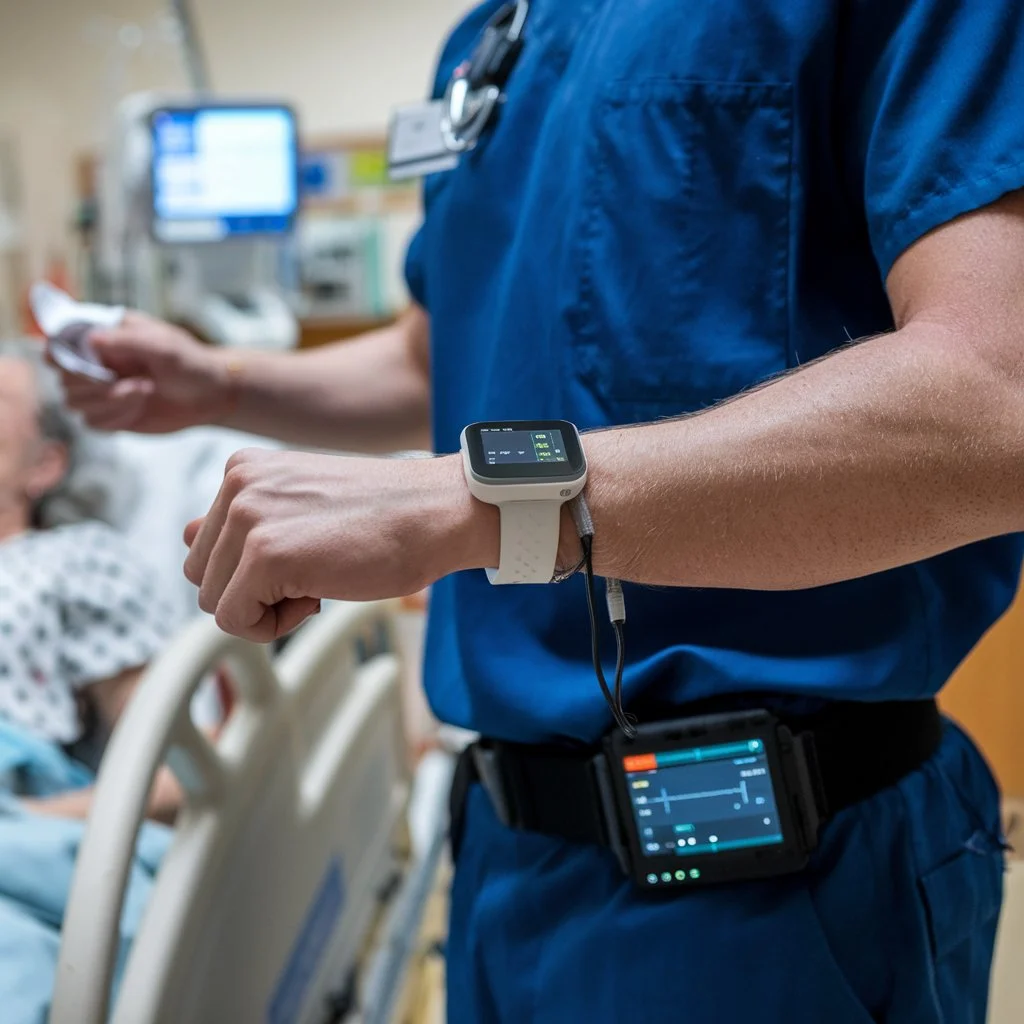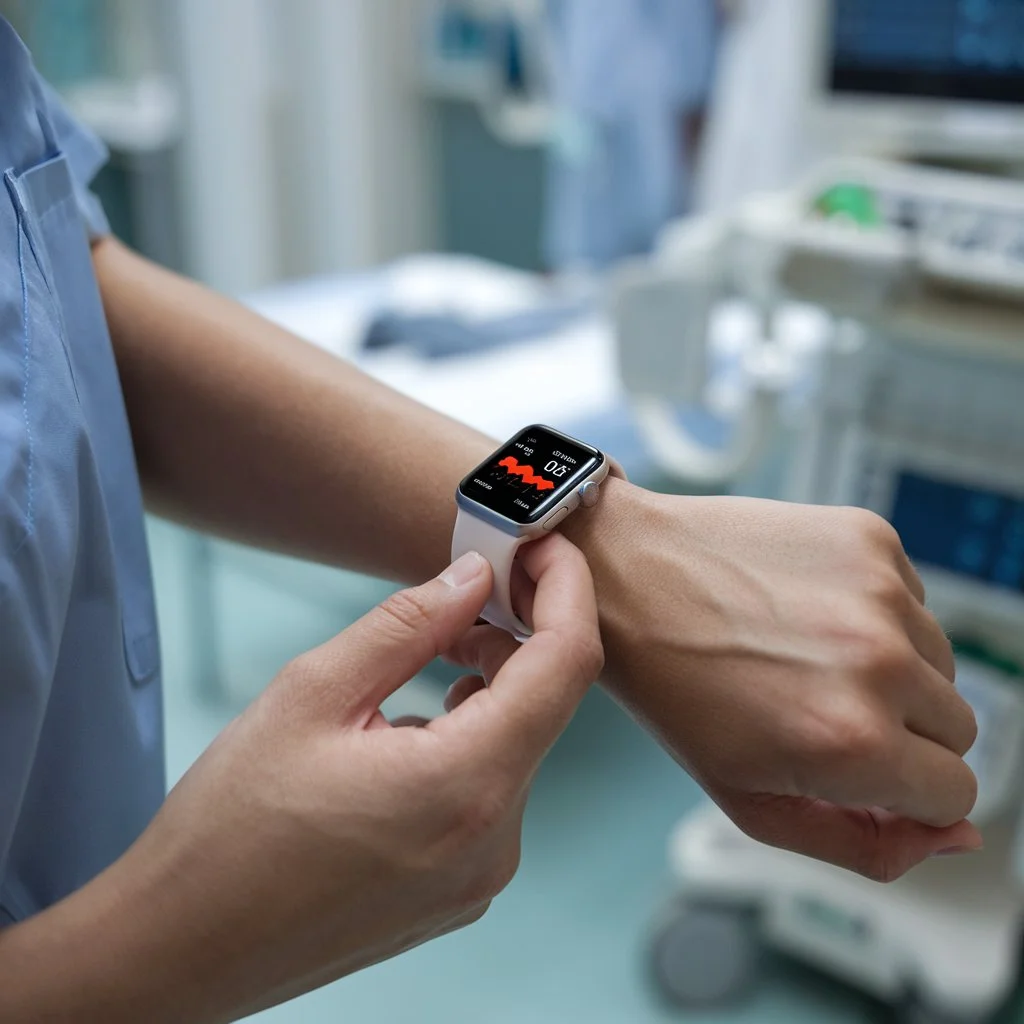In healthcare, wearable technology has become a major part of our day-to-day lives. They support health monitoring, exercise purpose attainment, and
In healthcare, wearable technology has become a major part of our day-to-day lives. They support health monitoring, exercise purpose attainment, and even through working with a healthcare provider, help to care for patients. In this article, we will examine how wearable technology is reshaping healthcare, making it easier for all to remain healthy and manage medical conditions.

Introduction to Wearable Technology in Healthcare
Wearable technology entails electronic devices that are worn by individuals, like watches or bands, which can monitor their health condition. This kind of health wearable captures information about the wearer’s body and gives insights into his/her health status. Medical wearables consist of devices used by physicians and patients to keep track of such aspects as heart rate, blood pressure, and even glucose levels in the blood. These devices provide people with an opportunity to better understand their health, giving them ways to improve it.
Types of Wearable Devices in Healthcare
Several wearable devices have been designed specifically to help users maintain good standards of health and fitness. Every type has its functions, although they aim at ensuring that the delivery of healthcare systems is more accessible and efficient.
Fitness Trackers
Activity trackers are favorite fitness accessories that count steps, and measure heart rates, among other things; some even help monitor sleep patterns. Such wrist-based tools enable people to lead an active lifestyle while achieving their wellness objectives. Most have step counters reminding individuals to walk more often to keep fit.
Smartwatches
Smartwatches are more advanced than fitness trackers since they not only count steps but also record pulse rates between heartbeats, indicating irregularities as well as measuring oxygen saturation levels in blood streams. Modern smartwatch features related to wellness show data almost instantaneously so that doctors may see them easily.
Continuous Glucose Monitors (CGMs)
These diabetes wearables ensure people suffering from diabetes monitor their blood sugar throughout daily life activities. The glucose monitor devices alert users when blood sugar becomes either too high or low, making it easier to manage this condition.
Wearable ECG Monitors
ECG wearable monitors are heart health wearables that track the electrical activity of the heart. Early diagnosis of arrhythmia and other heart ailments can be done with such devices, which are important for people suffering from cardiovascular diseases.
Wearable Blood Pressure Monitors
Blood pressure tracking wearable devices help people keep tabs on their blood pressure throughout each day. These hypertension wearables work best for individuals who need to frequently monitor high BP and make alterations to medications as needed.
Benefits of Wearable Technology in Healthcare
Patients and healthcare providers benefit greatly from wearable technology. The way health is monitored, care-giving is done, and how patients engage with their health status has improved due to these gadgets in hospitals.
Improved Patient Monitoring
Wearable technology has significantly improved patient monitoring. Digital doctors use remote patient monitoring tools which enable them to constantly check on their patients’ health without any need for a visitation. With real-time data collected by wearables, any changes in a patient’s condition can be addressed promptly.
Enhanced Preventive Care
On top of everything, wearables also contribute to the enhancement of preventive care measures taken by physicians. Such preventive health wearables incline towards early disease detection; hence allowing intervention as soon as possible at the onset stage. This helps prevent minor health problems from becoming major ones.
Personalized Health Care
This can be done through wearable technologies that collect information that guides healthcare plans. Physicians can customize treatments when they can track specific health markers and provide care based on current data.
Increased Engagement of Patients
Wearable devices allow more interaction with patients by giving them power over their health. When reminded or set goals using tools like health engagement gadgets, it boosts patient empowerment attitudes keeping them healthy.
Cost Reduction in the Healthcare Sector
The result is cost savings in the healthcare industry through wearables. Continuously monitoring chronic conditions at home is a healthcare cost-reduction strategy that can cut back on the number of hospital visits for patients. Wearable technology cost efficiency saves both medical facilities’ and clients’ money.
Applications of Wearable Technologies in Healthcare Settings
Different applications of wearable technology in healthcare include chronic disease management, fitness improvements, elderly care and fall detection systems, mental health tracking, and rehabilitation purposes.
Management of Chronic Diseases
These are important tools for people living with chronic conditions who need wearable techs to manage these diseases. These wearables for chronic disease help monitor symptoms and keep track of their progress which enables better control of illness management tools.
Fitness and Wellbeing Tracking
Fitness trackers are widely used as wearables to facilitate personal training exercises. They allow one to measure physical activity levels against predefined targets while keeping records of their progress. Monitoring wellness devices also track sleep patterns plus stress levels which allow people to maintain balanced lifestyles.
Aged Care Plus Fall Detection
Wearables also play a vital role in elderly care by providing fall-detection devices that alert caregivers if a fall occurs. Elderly wearables also monitor vital signs, ensuring that older adults receive timely help when needed.
Mental Wellness Tracking Devices
Wearable technology is also used for mental wellness monitoring such as stress tracking gadgets and mental health sensors which follow stress levels, and sleep patterns together with other indicators towards psychological well-being helping users manage their mind state.
Physical Therapy and Rehabilitation
Wearable rehab devices in physical therapy and rehabilitation are used for progress monitoring as well as proper completion of exercises. Physical therapy wearables provide feedback that helps both patients and therapists to improve outcomes in recovery.

Challenges Arising from Wearable Technology in Healthcare
Nonetheless, there are obstacles to the use of wearable health devices. These issues have to be addressed for these gadgets to reach their full potential.
Privacy and Security Issues
Significant problems have been raised about data security and privacy surrounding wearables. It is paramount that there be a proper wearable data security system since such gadgets gather private information concerning health. The trust built up around wearable technology crucially depends on healthcare data privacy being protected.
Accuracy and Reliability of Wearables
Wearable accuracy is subject to wide variations, which may result in discrepancies in the collected data. Serious concern arises from unreliable health information emanating from inaccurate wearable information.
Integration with Healthcare Systems
A different difficulty arises when it comes to integration into healthcare systems. Integration of wearable technologies with healthcare includes providing access for medical personnel to this type of statistical information. For clinical applications, such as making decisions based on wearable sensor-generated or self-reported data, the system must be compatible.
Expensive and Not Easily Accessible
High costs as well as limited access prevent many people from using this technology. If they are expensive, then they will not reach or benefit large numbers of people hence making them ineffective.
User Compliance and Engagement
User compliance and engagement are central elements required for effective wearability. Therefore, patients must be able to adhere properly so that these devices can work effectively. Patients must wear them to get accurate results which will help them manage their health properly.
The Future Of Wearable Healthcare Technology
The future appears bright for the integration of AI into healthcare through artificial intelligence, telemedicine, smart clothing, and precision medicine.
AI and Machine Learning in Wearables
The importance of AI and machine learning in wearables is increasing day by day. By incorporating AI into wearables’ systems, their analysis capability becomes stronger; thus promoting better care delivery through enhanced forecasting techniques on diseases. Wearables employing machine learning technology can get educated from the user’s data to become better with time.
Wearables and Telemedicine
The number of connected wearables and telemedicine is growing fast. With the help of wearables designed for telemedicine, distant health meetings become more effective and convenient.
Smart Clothing and Wearable Textiles
Healthcare is currently witnessing a rise in smart fabrics and wearable textiles. Smart fabrics can take measurements about someone when wearing them while developing textile health sensors helps capture vital signs without difficulty.
Wearable Implants and Biometric Sensors
This is an advanced stage where there are wearable implants as well as biometric sensors. Biometric devices and implantable health tech have been invented to provide constant monitoring for vital signs and other body parameters, which gives even more precise information.
Wearables in Precision Medicine
It makes highly personalized healthcare possible when it comes to wearable technologies in precision medicine. Precision health wearables will collect individual-specific data allowing customized medicine devices to offer directed therapy options.
Case StudiesSuccessful Implementation of Wearable Technology
Numerous case studies demonstrate that wearable technology has been successful in different sectors of healthcare.
Wearables In Chronic Disease Management
Great progress has been made by wearables in chronic disease management towards assisting patients deal with their conditions. They include various chronic diseases where health monitoring devices were used resulting in improved patient outcomes.
Wearables in Fitness and Wellness Programs
Fitness wearables have been instrumental in aiding people to meet their health objectives. Wearable technology put into use in fitness programs has brought success where people have made great improvements in both their health and physical fitness.
Wearables in Elderly Care
The use of wearable technology for elderly care has saved lives by ensuring safety. Examples of the use of wearable technology show that the risk of falls among elderly people is reduced through devices such as fall alert systems.
Wearables in Mental Health Interventions
Mental health wearables are helping patients manage stress and symptoms related to mental illness. Examples of successful usage of mental health wearables have been proven effective in reducing users’ stress levels and improving psychological wellness.
Conclusion
The healthcare sector is being revolutionized by wearable tech, enabling it to become more accessible, personalized, and efficient. These smart wearable gadgets have immense advantages including monitoring disorders like heart conditions or enhancing one’s physical being. Furthermore, an optimal future lies ahead for medical wearables due to the advances AI, telemedicine, and smart clothing technologies are making within this field. As wearable tech develops further, it will become an increasingly important tool for healthcare delivery which can enable individuals to live healthier lives.


COMMENTS